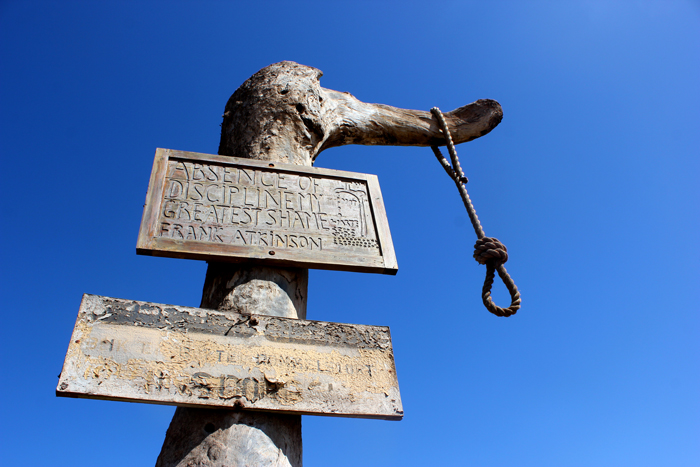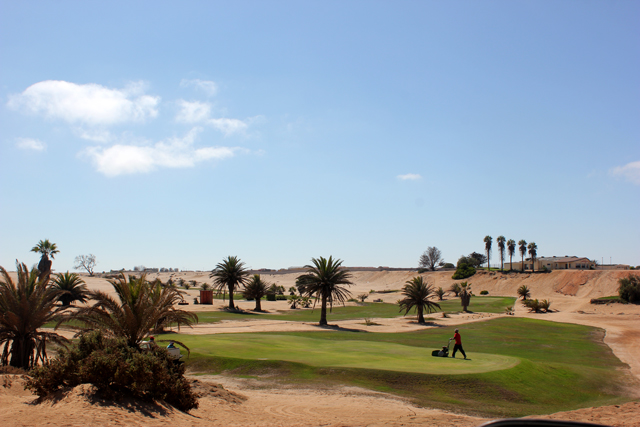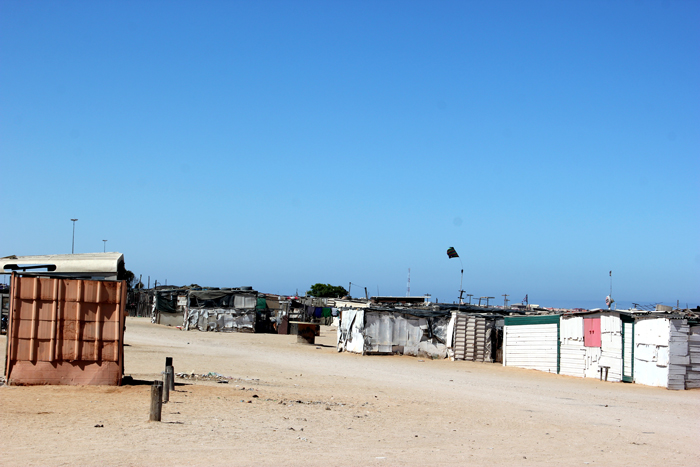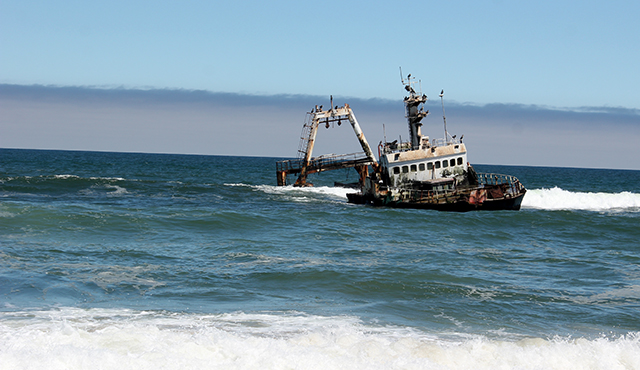The shipwreck Zeila, south of Henties Bay along the Skeleton Coast
By Will McGrath
Then we came out of the Namib Desert and arrived at a small beach town beside the Atlantic. My wife and I were traveling through Namibia with our two children—three and five—and an old friend from Lesotho, where we’d lived on-and-off over the last few years. Today we had come from Khorixas, 240 kilometers across airless flats of sand and rock, baking salt plains that swept cleanly to the edge of vision. As a joke I put on an album by Sigur Rós—I tried to imagine what music represented the opposite of where we were—but the glacial Icelandic squalling only amplified the fundamental loneliness of the place. I turned it off. We were on the moon.
Pastel houses were shoved up against the Atlantic—purple and bright blue, yellow, lime, and teal—all the colors a rebuttal to the dark churning of the sea.
Henties Bay felt like a pardon at first—implacable desert for hours, then suddenly a misty beach town materializing from the ether. The town seemed to have fled the desert too, then found itself cut off and surrounded by ocean. Pastel houses were shoved up against the Atlantic—purple and bright blue, yellow, lime, and teal—all the colors a rebuttal to the dark churning of the sea. Squat palms studded the town and through coastal vapors we could see Seussian flora sprouting in defiance of the desert’s minimalism. At the edge of town a sign in Afrikaans read: Hentiesbaai.
Two things were immediately noteworthy:
The first was a golf course situated in the dried bed of the Omaruru River, composed entirely of sand trap with occasional flourishes of irrigated green.
The second was a noose hanging from a tree near the center of town.
In 1884 Germany began colonizing the area that is now called Namibia—part of the infamous European “Scramble for Africa”—and what followed was fairly predictable: the German invaders usurped land and resources and occasionally lynched the indigenous people, the indigenous people revolted, and the Germans responded with uncompromising brutality. In 1904, General Lothar von Trotha began systematically slaughtering the Herero and Nama ethnic groups. “I know enough tribes in Africa,” Trotha wrote to the Imperial Colonial Office. “They yield only to force. It was and remains my policy to apply this force by unmitigated terrorism and even cruelty. I shall destroy the rebellious tribes by shedding rivers of blood.”
After the German Schutztruppe engaged the Herero with machine guns and artillery, they chased survivors into the desert, set up a military cordon, and waited for their enemy to become—as one official report put it—“the victim of his own environment.”
In October of that year Trotha issued an extermination order declaring that any Herero person (man, woman, or child; armed or unarmed) was to be executed if encountered within “German boundaries”—i.e. the southwest corner of the African continent where the Herero had lived for the past 300 years. The period that followed is now referred to as the Herero and Namaqua Genocide, which spanned from 1904 to 1907, and which Germany acknowledged a century later in a carefully-worded non-apology. The conflict went like this: after the German Schutztruppe engaged the Herero with machine guns and artillery, they chased survivors into the desert, set up a military cordon, and waited for their enemy to become—as one official report put it—“the victim of his own environment.” Most of the Herero people died slowly of starvation or thirst in the interior wilderness; laggards who didn’t make it out of range were bayonetted or hanged.
Trotha later lightened the tone of his extermination order: he instructed soldiers to shoot over the heads of women and children, enticing them to flee into the desert. He said his intention was to avoid sullying “the good reputation that the German soldier has acquired,” but in the end it didn’t matter—Trotha had the women and children executed anyway, some by machine gun, some burned alive in huts. The most graphic accounts from this period come from German settlers and soldiers themselves, who gave sworn testimony about the atrocities they participated in and witnessed. Conservative estimates claim that 60,000 Herero (75 percent of the ethnic group) and 10,000 Nama (50 percent of the ethnic group) were annihilated over the course of these few years.
It was the twentieth century’s first genocide. Namibia’s first governor, during the prelude to genocide, was Dr. Heinrich Göring—father of the infamous Nazi Hermann Göring, who would later found the Gestapo and command the Luftwaffe. The Germans also tinkered with the mechanism of the concentration camp in Namibia. Captured indigenous people were placed in work camps around the region and were frequently used for medical experimentation. The anthropologist Eugen Fischer—later another prominent Nazi—tested sterilization methods on Herero women in the camps and eventually wrote what would become the Nazi’s eugenics textbook. At the Shark Island concentration camp (near Lüderitz, Namibia) the physician Stabsarzt Bofinger also conducted experiments on prisoners, one of which involved injecting arsenic into Nama men. After the prisoners’ inevitable deaths, Bofinger measured brain sizes and shipped body parts to the University of Berlin, where they were used to demonstrate the similarities between the Nama people and anthropoid apes. It is hard not to see men like these as predecessors of Josef Mengele, Auschwitz’s Angel of Death, whose experiments on living prisoners were also aimed at substantiating the biological superiority of the Aryan race.
Most historians reject a bright causal line between these two German genocides. Others insist on the “uniqueness” and “singularity” of the Holocaust—although that labelling can register as a kind of ahistorical distancing, an effort to make alien an event that was profoundly modern and human.
Whatever the case, certain echoes are uncanny. In their book
The noose in Hentiesbaai hangs from a perfect natural gibbet: a gray crooked tree, long dead now, with a single branch jutting horizontally. Against the backdrop of the Atlantic the noose falls like a pendant pearl, and at the base of the tree is a marble placard:
“The Gallows—Erected in 1978 as an appeal to keep the town and beach clean, initiated by Frank Atkinson and Willie Cilliers, who respectively settled here in 1969 and 1971 as the first two residents of Henties Bay.”
“Jesus,” my wife says. “This is from 1978?”
Further up the tree is a rough wooden sign with words carved into it. I read aloud to her:
“Absence of discipline—my greatest shame. —Frank Atkinson.”
She looks over at me. “Where are we?”
In the middle of the twentieth century, a few decades after the Herero and Namaqua Genocide, Namibia was subjected to a version of apartheid courtesy of South Africa. It began in 1920 when the League of Nations asked South Africa to take over administration of Namibia, the Germans having been removed from power after the First World War. South Africa complied, accepting a paternal mandate to look out for the “well-being and development… and the interests of the indigenous population”—a responsibility that the League referred to as a “sacred trust of civilization.”
Throughout Namibia a South African white minority dictated where non-whites could live, where they could travel, what jobs they could hold, whether they could vote (they couldn’t), whether they could be murdered without repercussion (they could)—the list spirals outward in a series of grotesque and only-slightly-less-grotesque human rights violations.
By 1946 the League of Nations was disbanded and Namibia had slipped into political limbo, with South Africa attempting to annex the land (they considered it their “fifth province”) and the newly formed United Nations pushing back against the plan—resulting in impassioned speeches, passed resolutions, and general stasis.
So when the Afrikaner-led National Party instituted their racist policies throughout South Africa in 1948, the same apartheid policies applied in Namibia. (The remaining German settlers in the area were instrumental in electing the National Party, and the German Senator Heinrich Vedder later boasted—in the mainstream newspaper Der Spiegel, in 1960—that the Germans had been doing apartheid in Namibia long before the South Africans had.)
Throughout Namibia a South African white minority dictated where non-whites could live, where they could travel, what jobs they could hold, whether they could vote (they couldn’t), whether they could be murdered without repercussion (they could)—the list spirals outward in a series of grotesque and only-slightly-less-grotesque human rights violations. Non-whites were not allowed to own property, and many were forced to relocate to “reserves” (the South Africans were at least thoughtful enough to drop the word “game” from the term). Some non-white neighborhoods were bulldozed wholescale.
Only fifty years had passed since the League of Nations mandate, but South Africa had apparently grown hazy on the well-being, development, and best interests of Namibia’s indigenous population.
We stay overnight in Hentiesbaai, having come across a pleasant guest house by the sea, empty in the off-season. My wife and kids run along the beach, dodging waves, trying to shake off the desert’s monotony, while Nthabeleng—our friend from Lesotho—and I sit on the deck having a drink. Later I visit the town’s tourist website, which highlights some local attractions: the bizarre golf course, the excellent fishing. Then I come to an explanation of the noose, which is characterized as a “friendly but firm warning” to keep the town clean.
“This gesture is typical of Afrikaner humour,” the website continues, “seen as such without any negative connotation reflecting on obscure happenings such as real hangings or slavery (which is, by the way, not part of Namibia’s history).”
So that’s the explanation: Literal gallows humor.
The international community spent many years attempting to convince South Africa to relinquish control of Namibia, but the South Africans politely declined over and again. In 1966 the United Nations dissolved outright South Africa’s mandate to administer Namibia, a decision that was upheld in 1971 by the International Court of Justice. In 1977 a coalition including Canada, France, the United States, the United Kingdom, and West Germany launched a diplomatic effort to press the point of Namibian independence.
The next year, in 1978, the United Nations and neighboring southern African countries presented a proposal to hold free, fair, and multiracial elections in Namibia. South Africa again passed on this offer, choosing instead to hold rigged elections characterized by “massive organized intimidation by the South African authorities”—per the Electoral Institute for Sustainable Democracy in Africa—which manifested in the form of confiscated personal documents, illegal detentions, and brutal beatings for anyone who might be voting the wrong way.
This was the year that Frank Atkinson and Willie Cilliers hung the noose in Hentiesbaai.
To remind people to keep the beach clean.
In the morning we explore the town, which is divided cleanly in half. The lovely pastel beach houses look out at the ocean, nestled on streets with quaint maritime names: Duine, Dolfyn, Pelikaan, Katfisch, Cormoran. The black neighborhood is on the other side of the main road—away from the Atlantic and pressed back against the desert. Some houses here are modern, immaculately painted cinderblock with metal roofing, but very quickly a shantytown emerges: canted structures with clapboard siding and canvas strung over top, impromptu shelters of metal and tarp, houses cobbled together from car parts and driftwood and other salvaged materials. Here the streets are named after Namibian heroes—Samuel Maherero, Hendrik Witbooi, Iipumpu Tshilongo—kings and chiefs who fought the German colonizers around the turn of the last century.
We pass an empty soccer pitch, home to the local team—11 Bullets FC—whose name is painted on the outer wall, vying for attention amidst colorful graffiti. The field is entirely sand and gravel, with two netless goals bracketing the pitch, and in the noonday sun the stadium appears ready to host the last soccer match of the apocalypse. I stop here to talk with two residents of the neighborhood. A stout chatty man is waiting to pick up his son outside the primary school, passing time with the school’s security guard, tall and quiet, eyeing me uncertainly. I tell them we’re traveling in Namibia—from the United States, but living in Lesotho at the moment—and we talk about the local fishing scene in Hentiesbaai, a topic in which I am comprehensively ignorant.
Eventually I get around to my question. I ask them about the noose.
The two men share a look.
After a moment the chatty man says, “Ah, it’s just some historical thing.” He waves it off, shrugs.
I don’t know how to read his avoidance: distrust of a stranger, maybe, or silence as defense mechanism—or simply a reaction to the fact that white faces in the region have been responsible for so much suffering for so many years.
I tell them it’s an unsettling thing to see in public where I’m from—it’s a symbol in the United States, a threat. This is a bit disingenuous of course. I don’t add, as perhaps I should, that in America we just conceal our threats a bit more carefully, use prettier language. I don’t mention that the Confederate Battle Flag—a declaration of intent, a symbol of black slavery and white supremacy, a threat if ever there was one—still flew proudly from government flagpoles well into 2015.
The chatty man laughs uncomfortably.
“There’s no tension here,” he says after a moment. “This place is friendly.”
We head back to the town’s tiny commercial strip. In a café I talk with a black woman dressed in an ankle-length gray skirt and a serious blazer. She sits reading her bible—the pages are heavily highlighted, purples and pinks, greens and yellows, the same pastels as the beach houses. I ask her about Namibia, about Hentiesbaai, and she gives me some local history. Then I ask her about the noose.
“Do you want the official story?” she asks, and then repeats the version from the tourist materials, the dark Afrikaner joke, the incentive to keep the town clean.
“But you know this town used to be for whites only—a fishing town, a place for whites to go on vacation. Eventually they had to allow some blacks in to do the cleaning, the manual labor, those kinds of jobs.”
She pauses. “And so there are rumors of course.”
“About the noose?”
“Well,” she says, “they didn’t keep records about those things during apartheid, did they?”
After a moment she continues.
“But things are different now. In Namibia, apartheid was not as bad as in South Africa. Blacks are free here, we can go where we please. Some friends I know just moved to the nice houses—” she gestures toward the beach, then stops.
“Their neighbors did move away, but not everyone is like that. Some of the older whites still think that way, but it’s smaller now—maybe 10 percent, maybe 5 percent? And if they want to move away, let them.”
She looks down and places her hand on the bible.
“You want to know the truth? We Namibians are Christians. We forgive. It’s not how they are in South Africa. The president here, the ministers—we are all born again! We believe in reconciliation.”
We talk a while longer, but soon I have to go; we are driving further down the coast today. I apologize to the woman for interrupting her study, and thank her for talking with me.
“You know—” she says, as I am turning away.
She takes off her glasses, rubs her eyes, looks up at me.
“—I don’t understand why they don’t just take it down. Someone should get rid of that thing.”
On this trip through Namibia, my wife and kids and I are traveling with our friend Nthabeleng, a Mosotho woman we’ve worked with for many years, the managing director of an NGO in Lesotho. When we return to the guest house to settle up we are met by the manager of the place, a friendly Afrikaner woman around sixty. She comes to collect the bill, greeting us warmly and doting over our kids, but she doesn’t look at or acknowledge Nthabeleng. It doesn’t appear spiteful—the Afrikaner woman just seems to think that our friend is perhaps our nanny, or maybe something that doesn’t require acknowledgement, a piece of luggage, say.
The Afrikaner woman is delighted to hear that I am from the United States. Her son lives there now, she says, in a rural part of Wisconsin, and she takes this opportunity to wax romantic about the American Heartland.
“It’s so safe!” she says. “No danger, no crime—no problems!”
On the way out of Hentiesbaai we pass the surrealistic golf course one last time, where three black men are out in the sun manicuring fragmented islands of green, castaways in an ocean of sand. The Namib Desert reasserts itself immediately at the edge of town, the oldest desert in the world, effacing all markers of civilization. Once again everything is whitewashed.
But before we left town I had grabbed a brochure from the Hentiesbaai tourist office. There on the cover is the gallows tree—yet the tree is in silhouette so you can’t read the historical placards, can’t make out Frank Atkinson’s despairing cri de Coeur: Absence of discipline, my greatest shame!
It’s a strange brochure—it just looks like it has a picture of a dead tree on the front. The noose has been Photoshopped out altogether.




